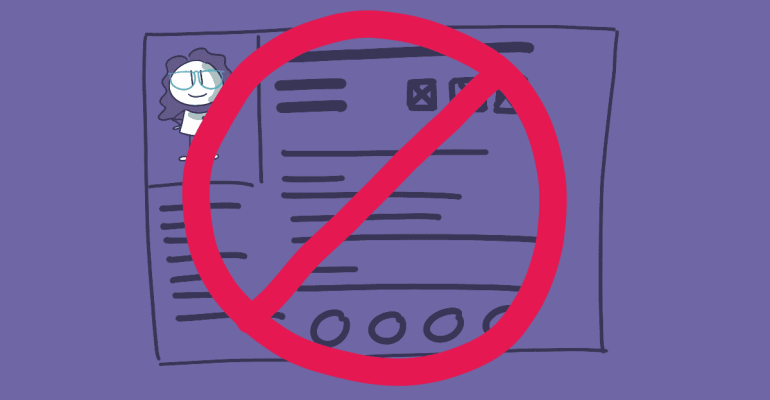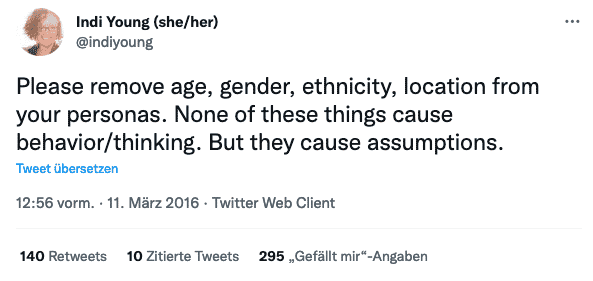Are Personas Evil? 4 Weaknesses of Personas You Must Consider Before Using Them
29. July 2022 2023-09-28 11:17Are Personas Evil? 4 Weaknesses of Personas You Must Consider Before Using Them
Personas seem to be an evergreen technique in product people’s toolboxes. However, they come with a few stumbling blocks and often quickly end up in the drawer. In the worst case, they even lead to wrong decisions in the design process.
This is a rough introduction to the subject and only the first article on this topic. So, let’s start with a brief classification.
Where do personas come from?
In the early 80ies, Allan Cooper, a software developer at that time, came up with the idea of personas. He had been looking for a way to empathise with the people who would use his software. In 1998, he published his book “The Inmates Are Running the Asylum”, in which he devoted a chapter to personas. From that point on, they became increasingly popular.
Allan Cooper described personas as “hypothetical archetypes of actual users” (Cooper, 1998), and he claimed that they need to be very specific so that the persona “becomes a real person in the minds of the designers and programmers” (Cooper, 1998).
What are proto-personas?
As long as personas are based merely on assumptions and general knowledge and not on actual empirical data, they are called proto-personas. Those rather represent what we believe our users are. Thus, they are usually plain and simple without much background information or detail.
How are personas created?
Of course, there is more than one way to create personas, but basically, the subsequent steps should always be followed:
- Get a picture of the target group or the users.
- Identify patterns and commonalities or differences (segmentation).
- Work out critical criteria and characteristics – and those should focus on behaviour, needs, pains and such.
- Craft out the personas.
I would say those are the minimum requirements for proto-personas. As a next step, or even before you start segmentation, you should conduct interviews with people from the target group. The information from these interviews then forms the basis for your personas or validates or falsifies the proto-personas.
Personas must be revised regularly, and every new research should be held against them.
In recent years, more and more doubts have arisen about the usefulness of personas. Some even say that they should be removed from our UX toolboxes. Let’s take a look at the 4 biggest quirks.
Drawback #1: they are bulky in use
Do you know of an example of personas successfully being created and permanently introduced into design processes? I honestly don’t.
I have seen many personas disappear into drawers and fade away on office walls. Months had gone into their development, and ideas had been forged on how to get around their potential disappearance.
One of my clients, for instance, had a print shop print persona set cards that were distributed to all employees and were also part of the onboarding package for new employees, with moderate success. Another customer had the personas printed out and hung on the passage doors into the hallways that all employees passed every day. But they received little attention. I even saw life-size cardboard stand-ups – but they didn’t factor into the design process either.
But why? How can it be that all the work doesn’t pay off? What makes elaborated personas so cumbersome?
On the one hand, the colleagues outside your product or design department – even if you are a user-centric company – don’t have your users in mind the whole day. They have tasks and processes that are mostly far away from what you do. And if you’ve built very detailed personas with a lot of text: TL;DR! Nobody has time these days. We need easily digestible information and something that we can remember.
And it’s the same in our own departments. We create personas, and when they are ready, we pat ourselves on the back and move on to our next task, our next story, or our next ticket. However personas should not be used as a standalone tool. Instead, many other prototypes can and should be created based on them. For example, empathy maps, storyboards, or user journey maps.
Drawback #2: they require a lot of care
It’s not enough to conduct a few interviews, derive personas from them, and then that’s it. Personas are snapshots and should be treated like those. The moment you create them, they are outdated. So, better refrain from wallpapering the office with them.
Personas are there to work with. We should constantly question and revise them – just like all our documents. After each new research we conduct, we should compare the findings with our personas and, if in doubt, adjust or even discard them. Yes, sometimes this even means “Kill Your Darlings”!
So maybe the drawback is not that they require a lot of care. It’s instead, because of this, they are not made to be published. They are not made to be distributed on a large scale. Because this way, they can’t be revised well, and outdated versions hide everywhere.
Drawback #3: they may generate a false framing and bias
Now we get to the real problems and reasons you might want to stay away from personas.
People who were not involved in the creation may not completely understand them or even misinterpret them. Allan Cooper’s idea of real people in the minds of designers and developers has not always proven to be the best track. On the contrary, especially stakeholders who are less involved often assume that these described users actually exist. That 30-year-old Tina really lives in a suburb of Munich, commutes to work every day, and reads the news on her brand-new smartphone.
But this Tina doesn’t exist – and if she does, it’s a mere coincidence. However, through this solid specification up to the point of creating a “real” person, many other users are not displayed, and their needs and challenges are not considered. And let’s face it, this is a dangerous bias that happens even to us product people.
Today, therefore, the recommendation is actually to be less specific. Do not use photos, names and demographic criteria unless it’s crucial data for your project. But is the remainder still a persona?
Also, by highlighting single aspects, it can happen fast that we are focusing on the wrong things and running in the wrong direction. For instance, are the brand-new smartphone and the commute really the most critical factors in Tina’s Journey (and even more so in the people’s journey that Tina represents)?
Drawback #4: they are not inclusive
To be honest, this point is the continuation of drawback #3. By trying to represent very abstract, generic criteria in a very concrete and specific way, we automatically deprive ourselves of the possibility of inclusion and diversity.
One rule of personas is that there should not be too many. But how can we represent an eclectic range in this way? The answer is: We can’t. Oversimplification and generalisation prevent diverse representations. And this again leads to many people being excluded and their needs thus not considered!
Conclusion
You may have already read my opinion between the lines: Personas are a tricky and treacherous tool with many pitfalls. They are not ideal if you don’t know how to handle them. But there are many modern substitutes out there. I will discuss some of them in the future and even present my own alternative – but that one’s still in the oven 😉👩🍳
So stay tuned and stick your head in some of the subsequent readings in the meantime.
Relevant resources
Cooper, A. (1998). The Inmates Are Running the Asylum: Why High Tech Products Drive Us Crazy and How to Restore the Sanity (2nd Edition). Pearson Education.
Harshadewa (2018). Here’s why you should stop using Personas. Medium. https://uxdesign.cc/heres-why-you-should-stop-using-personas-63c09a844e67
Roman, C. (2019). The Problem with Personas. Medium. https://medium.com/typecode/the-problem-with-personas-b6734a08d37a
Thelwell, C. (2017). Are personas ruining your product? Invision. https://www.invisionapp.com/inside-design/personas/










